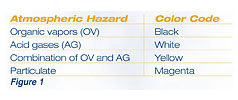
The basis of any good respiratory protection program is the trained program administrator required by 29 CFR 1910.134 (c). This person must not only know and understand the requirements of a respiratory protection program but must understand the details of training, medical monitoring, fit testing procedures, respirator seal check procedures, respirator cleaning procedures, and respirator selection and use.
Before a respirator can be selected, at least the following factors must be known: the amount of oxygen in the workplace air, the contaminant(s) that are present, how much contaminant(s) are present, the tasks the respirator wearers will be doing, and what changes, if any, are likely to occur.
While there are two basic types of respirators — atmosphere supplying and air purifying — this article will focus on air purifying respirators (APRs). These are equipped with three basic types of filters, cartridges or canisters — particulate, gas or vapor, and combination of particulate and gas or vapor.
Where to find help
Recently, several publications aimed at helping respirator wearers select and use the proper respiratory protection, especially APRs, have been issued. First, NIOSH published the Respirator Selection Logic 2004 [DHHS (NIOSH) Publication 2005-100]. Section II of this document describes respirator selection criteria and restrictions on respirator usage. The 11-step respirator selection logic sequence in Section III is a concise, easy-to-use logic tree consisting of a series of yes-no questions to select the proper respirator. Section IV covers escape respirators, while Section V provides information on other hazards typically encountered in environments where respirators are used. Check www.cdc.gov/niosh to obtain a copy of this document. Change schedules for filters and cartridges are discussed in an appendix.More detail on filter and cartridge change schedules is available on a compact disc, Breakthrough 2004, also available from NIOSH (pubstaft@cdc.gov or 1-800-35-NIOSH). This generic program is fairly easy to use. Parallel systems, incorporating the same basic principles, are available from most APR manufacturers for types of facepieces, protection provided by specific cartridges, and estimated cartridge life or cartridge change-out schedules. The major equipment suppliers provide software to predict how long a cartridge or filter will provide protection under user-specified conditions, and in some cases to help in selecting the proper facepiece. These programs are useful not only for actual working conditions but also for classroom training aids.
Finally, a new and expanded NIOSH Pocket Guide to Chemical Hazards, dated September 2005, is available in printed format [DHHS (NIOSH) Publication 2005-149] and as a compact disc [DHHS (NIOSH) Publication 2005-151]. As with previous editions of the Pocket Guide, specific respirator recommendations are made for 677 chemicals. In the new Pocket Guide, chemicals are indexed by chemical name, synonym or trade name.

Breaking the code
Cheek- or chin-mounted cartridges and filters tell the wearer about the protection they provide, if the wearer can break the information code. First, gas and vapor cartridges are color-coded. Color codes were in the OSHA respirator protection standard until it was modified and updated in 1998. Now color codes are defined in American National Standard Institute (ANSI) standards. The label should always be checked for the specific protection and use for each specific cartridge or filter, but Figure 1 provides general guidance.There are more approved colors than those in Figure 1, but these are some of the most common cartridges encountered. Particulate air purifying filters are identified both by color and a letter-number code. These codes are shown in Figure 2.
The number codes refer to the percent of particles with an aerodynamic diameter of greater than 0.3 microns the filter will retain. There are three levels of efficiency:
- 95: Retains nearly 95% of particles
- 99: Retains nearly 99% of particles
- 100: Retains nearly 100% of particles
Fit testing
When selecting respiratory protection equipment, the protection provided by the system is based on the type of fit test that was conducted. Quantitative fit tests, the method of fit testing preferred by NIOSH, measure the “fit†or protection during specific exercises. Quantitative fit testing protocols include generated aerosol devices, condensation nuclei counters and controlled negative pressure devices.Qualitative fit testing protocols rely on the wearer being able to detect a challenge agent. Authorized agents include isoamyl acetate (banana oil), denatonium benzoate (Bitrex®), saccharin solution, or irritant smoke (stannic chloride). If a qualitative fit test is used, assigned protection factors (APFs) listed in Table 1 (Particulate Respirators), Table 2 (Gas/Vapor Respirators) or Table 3 (Combination Gas/Vapor and Particulate Respirators) in the 2004 NIOSH Respirator Logic discussed earlier must be used.
Keep in mind that respirators are the last line of defense. They are used only if engineering controls cannot be used to maintain safe atmospheres in the workplace. Think of a sidewalk after a winter storm — it is better to remove ice and snow (i.e., engineering controls) than to wear padded clothing to cushion a fall on the ice.